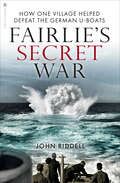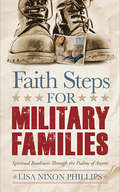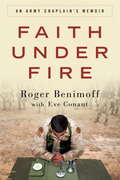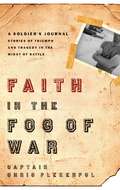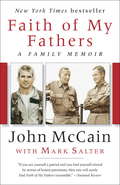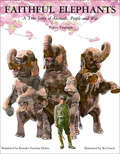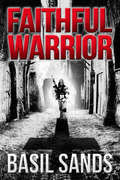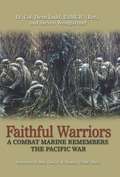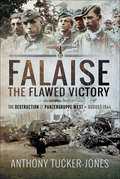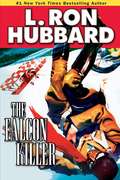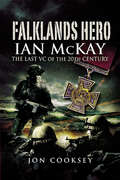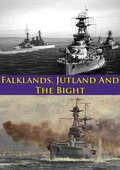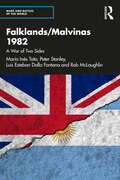- Table View
- List View
Fairchild Republic A-10 Thunderbolt II: The 'Warthog' Ground Attack Aircraft
by Peter C. SmithA comprehensive account of the origins, design, and history of the A-10A Warthog: “Highly recommended.” —AMPS IndianapolisIncludes photosThe Fairchild-Republic A-10A Close Support aircraft has become a legend over its long front line life. Known as the Warthog due to her unusual appearance, this little aircraft has built up an awesome reputation in the specialized ground-attack role, where her accuracy and deadliness are widely recognized as the best of their kind.Hard lessons from World War II, which were reinforced by the bitter experience of the Vietnam War two decades later, showed it was both impracticable and cost-inefficient to use supersonic fighter jets in the close air support mission. A requirement was therefore drawn up for a plane capable of carrying a heavy and varied load of ordnance, which had good endurance and unprecedented maneuverability and could survive heavy ground fire—thus the A-10 was born. But by the time it came into service its role had changed to that of a tank-buster in the defense of Western Europe in the face of the overwhelming numbers of Soviet battle armor.With her straight wing, twin tails, and turbine engines mounted high on her rear fuselage, this single-seat aircraft certainly presented a unique appearance. But all these features served a vital role, as Peter C. Smith explains in this highly detailed study.Although the Warthog’s expected missions on the plains of Germany did not materialize, she did destroy hundreds of Soviet-built tanks during the Gulf wars. The A-10 has also flown almost continuous missions over the Balkans, against the Taliban in Afghanistan, and ISIS in Iraq and Syria. This beautifully illustrated and comprehensive volume brings the A-10’s incredible story right up to date.
Fairhaven Rising (Saga of Recluce #22)
by L. E. Modesitt Jr.Modesitt continues his bestselling Saga of Recluce with his twenty-second book in the long-running series. Fairhaven Rising follows The Mage-Fire War.Sixteen years have passed since the mage Beltur helped to found the town of Fairhaven, and Taelya, Beltur's adopted niece, is now a white mage undercaptain in the Road Guards of Fairhaven.Fairhaven's success under the Council has become an impediment to the ambition of several rulers, and the mages protecting the town are seen as a threat.Taelya, a young and untried mage, will find herself at the heart of a conspiracy to destroy her home and the people she loves, and she may not be powerful enough to stop it in time.Saga of Recluce#1 The Magic of Recluce / #2 The Towers of the Sunset / #3 The Order War / #4 The Magic Engineer / #5 The Death of Chaos / #6 Fall of Angels / #7 The Chaos Balance / #8 The White Order / #9 Colors of Chaos / #10 Magi’i of Cyador / #11 Scion of Cyador / #12 Wellspring of Chaos / #13 Ordermaster / #14 Natural Order Mage / #15 Mage-Guard of Hamor / #16 Arms-Commander / #17 Cyador’s Heirs / #18 Heritage of Cyador / #19 The Mongrel Mage / #20 Outcasts of Order / #21 The Mage-Fire War / #22 Fairhaven RisingStory Collection: Recluce TalesOther Series by L.E. Modesitt, Jr.The Imager PortfolioThe Corean ChroniclesThe Spellsong CycleThe Ghost BooksThe Ecolitan MatterAt the Publisher's request, this title is being sold without Digital Rights Management Software (DRM) applied.
Fairlie’s Secret War: How One Village Helped Defeat German U-Boats
by John RiddellDuring the Second World War the Royal Navy’s vitally important Anti-submarine Experimental Establishment was secretly moved from Portland in Dorset to the Ayrshire village of Fairlie, to escape German bombing on the south coast. For the next six years it occupied the boatyard of yacht builder William Fife on the Firth of Clyde. During this time, highly confidential world-leading research on the acoustic detection of submarines by asdic – now known as sonar – was carried out by hundreds of scientists, officers and local men and women based at Fairlie. As experiments took place into new ways of sinking German U-boats, the peace of the quiet village was shattered. Winston Churchill described the work done at Fairlie as critical to winning the Battle of the Atlantic and ultimately the war. The research remained relevant to anti-submarine warfare long after the war, and is still relevant today. Fairlie’s role in the war was not disclosed until relatively recently. Highly illustrated throughout and making use of previously unpublished material, this book tells the full story of the establishment at Fairlie for the first time. It describes the impact it had on local people, and their relationship with the naval officers and scientists who came to work there.
Faith Steps for Military Families: Spiritual Readiness Through the Psalms of Ascent
by Lisa Nixon PhillipsA book of Christian wisdom, comfort, and strength derived from the Bible specifically for military personnel and their families during times of deployment.There is much preparation made in advance of an upcoming deployment, but sadly spiritual readiness rarely makes it to the check-off list. While war may inflict injuries on the souls of our service members, faith is the balm that can help the healing process and make a difference when living under difficult circumstances.Faith Steps for Military Families explores the themes of the fifteen Psalms of Ascent (Psalms 120–134) in the Bible’s book of Psalms. These special psalms reveal God’s wisdom about common military concerns, such as living in unfriendly environments, enduring desperate times, and coping with unforeseen conditions. They also touch on many other issues faced by twenty-first century military families, such as family resiliency, trusting in God during times of fear, and a deeper understanding of God’s nature as protector, keeper, and the night watchman.Lisa Nixon Phillips, a retired military wife shares some of her experiences, while walking you through these essential and richly meaningful verses.
Faith Under Fire: An Army Chaplain's Memoir
by Roger Benimoff Eve ConantWhen he left for his second tour of duty as an Army chaplain in Iraq, Roger Benimoff noted in his journal: I am excited and I am scared. I am on fire for God. He is my hope, strength, and focus. But not long after arriving in Iraq, the burdens of his job began to overwhelm him. Benimoff felt the pillar of strength he'd always relied on to hold him up--his faith in God--begin to crumble.
Faith Under Fire: Stories of Hope and Courage from World War II
by Steve RabeyThe Second World War generation met many challenges, and turned to their faith to sustain them through overwhelming odds. Here are stories of faith told by the people who lived them. this compelling collection not only honors the lives of these people of faith, but inspires readers to seek God in their own lives. Steve Rabey has spent time with the brave men and women who lived through WWII. He offers us touching glimpses into the souls of these who faces unbelievable adversity and emerged with a deep-rooted faith in God. This compelling narrative recounts the experiences of ordinary people with extraordinary faith and courage. Their profound stories will encourage and inspire you.
Faith in the Fight: Religion and the American Soldier in the Great War
by Jonathan H. EbelFaith in the Fight tells a story of religion, soldiering, suffering, and death in the Great War. Recovering the thoughts and experiences of American troops, nurses, and aid workers through their letters, diaries, and memoirs, Jonathan Ebel describes how religion--primarily Christianity--encouraged these young men and women to fight and die, sustained them through war's chaos, and shaped their responses to the war's aftermath. The book reveals the surprising frequency with which Americans who fought viewed the war as a religious challenge that could lead to individual and national redemption. Believing in a "Christianity of the sword," these Americans responded to the war by reasserting their religious faith and proclaiming America God-chosen and righteous in its mission. And while the war sometimes challenged these beliefs, it did not fundamentally alter them. Revising the conventional view that the war was universally disillusioning, Faith in the Fight argues that the war in fact strengthened the religious beliefs of the Americans who fought, and that it helped spark a religiously charged revival of many prewar orthodoxies during a postwar period marked by race riots, labor wars, communist witch hunts, and gender struggles. For many Americans, Ebel argues, the postwar period was actually one of "reillusionment." Demonstrating the deep connections between Christianity and Americans' experience of the First World War, Faith in the Fight encourages us to examine the religious dimensions of America's wars, past and present, and to work toward a deeper understanding of religion and violence in American history.
Faith in the Fog of War: Stories of Triumph and Tragedy in the Midst of War
by Chris PlekenpolWar-Worn Faith You want the flare of your faith to burn as intensely as a fire on the battlefield. That means digging into God's truth regardless of the chaos raging around you. These devotions are written by a man who had considered war something that someone else always did, and was then himself deployed to Iraq as a company commander. From the frontlines of the blackest days and in the face of inexplicable suffering, you'll discover the heart of the question, "Why, God?" and its often unsettling answer. Because in war, as in contemporary America , reality involves struggle, trial, and triumph. Let God meet you in the midst of life's nonsense to find the peace that is a crucial part of His impeccable plan. Why, God? War screams the same questions whispered in everyday life. The battlefield explodes with the same tenacity of emotions that wretch our souls. Smoke fills the air just as doubt clouds our minds. Are you on the frontlines of war overseas? Or perhaps your battle is personal, deep within. These devotions, penned by Captain Chris Plekenpol while on the battlefield in Iraq, expose the depths of inexplicable suffering as well as the heights of incredible victory in God. Through every adversity and in any circumstance, you will find a still voice reminding you of God's sovereignty...in war and peace. "Faith forged in the crucible of combat! Chris Plekenpol is a warrior and he has compiled a great guide for victory in the battles we all face." Oliver L. North Host of "War Stories" on Fox News and author of The Assassins "There is no theory here. Just the battle-tested insights of a soldier who has learned to trust his heavenly Father in the valley of the shadow of death. You are going to love this book." Andy Stanley Pastor, North Point Community Church "Amazing encouragement from the heart of the battle!" Louie Giglio Passion Conferences Story Behind the Book"I began writing devotionals as both a preparation for seminary and as a ministry tool during my service in Korea . At first, I sent them only to a few people. Then, as I wrote more frequently, I received e-mails requesting my devotions. I continued writing during my deployment to Iraq , tackling such issues as life in combat as well as the triumph of God in the battle. My purpose in writing this book is to further God's work in my life by ministering to others through my experience in the heart of the battle." --Chris PlekenpolFrom the Trade Paperback edition.
Faith of My Fathers: A Family Memoir
by John Mccain Mark SalterJohn McCain is one of the most admired leaders in the United States government, but his deeply felt memoir of family and war is not a political one and ends before his election to Congress. With candor and ennobling power, McCain tells a story that, in the words of Newsweek, "makes the other presidential candidates look like pygmies." John McCain learned about life and honor from his grandfather and father, both four-star admirals in the U.S. Navy. This is a memoir about their lives, their heroism, and the ways that sons are shaped and enriched by their fathers. John McCain's grandfather was a gaunt, hawk-faced man known as Slew by his fellow officers and, affectionately, as Popeye by the sailors who served under him. McCain Sr. played the horses, drank bourbon and water, and rolled his own cigarettes with one hand. More significant, he was one of the navy's greatest commanders, and led the strongest aircraft carrier force of the Third Fleet in key battles during World War II. John McCain's father followed a similar path, equally distinguished by heroic service in the navy, as a submarine commander during World War II. McCain Jr. was a slightly built man, but like his father, he earned the respect and affection of his men. He, too, rose to the rank of four-star admiral, making the McCains the first family in American history to achieve that distinction. McCain Jr.'s final assignment was as commander of all U.S. forces in the Pacific during the Vietnam War. It was in the Vietnam War that John McCain III faced the most difficult challenge of his life. A naval aviator, he was shot down over Hanoi in 1967 and seriously injured. When Vietnamese military officers realized he was the son of a top commander, they offered McCain early release in an effort to embarrass the United States. Acting from a sense of honor taught him by his father and the U.S. Naval Academy, McCain refused the offer. He was tortured, held in solitary confinement, and imprisoned for five and a half years. Faith of My Fathers is about what McCain learned from his grandfather and father, and how their example enabled him to survive those hard years. It is a story of three imperfect men who faced adversity and emerged with their honor intact. Ultimately, Faith of My Fathers shows us, with great feeling and appreciation, what fathers give to their sons, and what endures.From the Hardcover edition.
Faith under Fire
by Edward MadiganAfter the Great War some texts by British Army veterans portrayed the Anglican chaplains who had served with them in an extremely negative light. This book examines the realities of Anglican chaplains' wartime experiences and presents a compelling picture of what it meant to be a clergyman-in-uniform in the most devastating war in modern history.
Faith, Hope and Rice: Private Cox's Account of Captivity and the Death Railway
by Ellie TaylorFred Cox, a young soldier in the East Surrey Regiment, was taken prisoner by the Japanese at the fall of Singapore in February 1942. The next three and a half years were spent in a series of PoW camps, notably in Thailand working on the aptly named Death Railway. Fortunately he was not one of the 12,000 Allied prisoners who perished as a result of extreme maltreatment, starvation or disease, but his health, both physical and psychological, was seriously affected. After liberation, whilst in hospital in Ceylon, Fred was nursed by Joan whom he married. Advised by the doctors to face his horrific experiences, he and Joan spent the winter of 1946 1947 getting his story down on paper. Seventy years on, sadly after his death, Faith, Hope and Rice, (which were what sustained Fred through his ordeal) can now be shared with a wider audience. Readers cannot fail to be moved by the author's and his comrades' inspiring courage and resilience in the face of extreme adversity and ever present death.
Faithful Elephants: A True Story of Animals, People and War
by Yukio TsuchiyaThis beautifully illustrated children&’s book offers a sobering lesson about the horrors of war through the lens of a Japanese zoo during WWII. At Tokyo&’s famous Ueno Zoo, a zookeeper recounts the story of three performing elephants—John, Tonky, and Wanly—who became casualties of the Second World War. As bombs fell nightly on the city, the zoo was in danger of destruction. In the interest of public safety, instructions were given to kill the potentially dangerous animals. Still, the elephant&’s keepers wept and prayed that the war would end so that their beloved elephants might be saved. Originally published in Japan in 1951, this heartbreaking historical tale is now available in English with beautiful watercolor illustrations by Ted Lewin.
Faithful Warrior
by Basil SandsA retired Marine turned pastor becomes a reluctant warrior in this explosive thriller from an author who “is fearless in his storytelling” (Scott Sigler, #1 New York Times–bestselling author).God forgives when we ask sincerely.Men, not so much.Self, even less.And the Dead . . . never.Pastor Mike Farris loves his family, and loves his flock. Life is good, but to get there he had to traverse a trail of blood. The faces that haunt his nightmares are no longer just specters, and a long-thought-dead enemy is about to unleash a very real hell.Praise for Basil Sands and his thrillers“Basil Sands is one awesome writer, penning stories pumped with enough adrenaline that you’ll suffer from insomnia until you read the last word. This is one writer not to be missed.” —Jeremy Robinson, New York Times–bestselling author“Basil Sands’s Ice Hammeris a gripping, can’t-put-it-down series that works at every level. It’s got it all: love, war, treachery, and heroism. A home run!” —John Gilstrap, New York Times–bestselling author“Basil Sands has a knack for blending action and intrigue in an all-too realistic setting. In Karl’s Last Flight, the future is reminiscent of our recent past. I just hope there are heroes like Basil’s heroes fighting on our side.” —Evo Terra, founder of Podiobooks.com
Faithful Warriors
by Steven Weingartner Dean LaddFaithful Warriors is a memoir of World War II in the Pacific by a combat veteran of the 8th Marine Regiment, 2nd Marine Division. Written with award-winning author Steven Weingartner, Ladd's book chronicles his experiences as a junior officer in some of the fiercest fighting of the war in the Pacific. His recollections and descriptions of life--and death--on the far-flung island battlefronts of the Pacific War are vividly rendered, augmented by the recollections of a number of the men with whom he served.This memoir tells the story of how both Ladd and the Marine Corps came of age during history's greatest military conflict. His journey through the war is representative of many Marines in World War II: training outside of San Diego just before the war, awaiting the Japanese attack after Pearl Harbor as part of the Marine garrison on Samoa, surviving the savage fighting on Guadalcanal, resting and recuperating afterwards in New Zealand; participating in the bloodbath on Tarawa; recovering in Hawaii after being wounded; and returning to face combat yet again on Saipan and Tinian.Ladd is at his best when he is describes exactly what he saw, heard, and smelled within the mythical 50-yard circle of his foxhole. From his narrative we learn of the bravery of men who mustered the courage to scramble down the nets for the landing craft, after facing the veteran's fatalistic fear that one's luck in surviving the next battle would surely run out and knowing the ferocity that would come.
Faithful in Adversity: The Royal Army Medical Corps in the Second World War
by John BroomAn account of the World War II heroics of the corps that &“revolutionized medical care for British troops . . . Most Highly Recommended&” (Firetrench). On 28 September 1945, Field Marshal Montgomery expressed his &“admiration and high regard to a corps whose contribution to victory has been beyond all calculation.&” The Royal Army Medical Corps was active during all engagements in the Second World War. From the defeat in Norway in 1940 to the hell of Dunkirk and the fall of France, from the chaos of the retreat through Greece and Crete to the war&’s turning point in the vast deserts of North Africa, from the intensity of D-Day and the Normandy campaign to the reverses at Arnhem and the eventual liberation of the German death camps and Far East prison camps, RAMC personnel were frequently at the heart of the action, risking their lives to provide medical support to a mobile army in a highly mechanized war. For those taken prisoner by the enemy, maintaining the physical and psychological well-being of their fellow captives became an urgent necessity, while for a small number of exceptionally brave and hardy souls, attachment to commando units saw them provide medical support for some of the most daring raids of the war. Nearly 3,000 RAMC doctors and orderlies were killed during the war as a result of enemy action or exposure to dangerous tropical diseases. Using previously unpublished archival material and personal family papers, this book sheds fresh light on the experience of the regulars, volunteers and conscripts who gave expression to the motto of the RAMC: Faithful in Adversity.
Falaise: The Flawed Victory–The Destruction of Panzergruppe West, August 1944
by Anthony Tucker-JonesThis WWII history critically reexamines one of the most dramatic and significant battles to follow the D-Day landings in Normandy. The destruction of the trapped German forces in the Falaise pocket in August 1944 is one of the most famous episodes of the Normandy campaign. But myths have grown up around the battle, and its impact on the course of the war is often misunderstood. In this meticulously researched study, Anthony Tucker-Jones dispels misconceptions about the battle, describes the combat in graphic detail, and reassesses the outcome in the context of the campaign to liberate Europe. Tucker-Jones takes a broad view of the sequence of operations that culminated in the battle at Falaise, tracing the course of the campaign mainly from the panzers&’ viewpoint. For two bloody months following the Normandy landings, the panzers held the Allies at bay. But when they found themselves blocked in at Falaise, the area became a killing ground. Some liken the event to Hitler&’s defeat at Stalingrad, while others argue the victory was flawed because so many German troops escaped.
Falcon Killer, The
by L. Ron HubbardEnjoy this gripping and gritty tale. China's war ace, a fighter pilot nicknamed "The Falcon Killer (Tzun Kai)," is actually Bill Gaylord, raised in Peking by his American parents. Gaylord lost both of them as a child during the violent Boxer uprising and then saw his foster family slaughtered in wartime. With a past that's hardened his soul and given him nerves of steel, Gaylord has used his resolve to down more Japanese aircraft than can be counted.When he's not hunting down enemy planes, intrigue constantly follows him--stars of Tzun's rogues gallery include an agent provocateur and a despotic Chinese warlord. Soon enough, events pit Gaylord against a Japanese spy who has caused untold trouble for the Chinese. Gaylord must somehow find and defeat him or risk losing an ancient Chinese kingdom to the land of the rising sun. "Hubbard writes with his usual gusto ('Wings in the sky had passed their shadows over the land to drop their acrid death'), and Gaylord is a typical Hubbard hero, tough and wily but also introspective and romantic." --Booklist
Falcon Seven
by James W. HustonNew York Times bestselling author James W. Huston returns with his most powerful thriller to date. Exploding with international intrigue, sizzling courtroom drama, and heart-stopping action, Falcon Seven delivers an all-too-realistic tale of America under fire. A U.S. Navy F/A-18 flying over Afghanistan is suddenly diverted and ordered to bomb a building in Pakistan, where a meeting between al Qaeda and the Taliban is taking place. After destroying their target, the fighter jet is immediately hit by Stinger missiles and the pilots eject over Pakistan. They are captured, assaulted, and dragged through the streets of Peshawar. The world is on edge. The fliers are quickly forced onto a waiting Falcon jet headed for the Netherlands, where they'll stand trial for war crimes at the International Criminal Court. The building they hit was actually a medical post constructed by Europeans for Afghan refugees--and sixty-five innocent people were killed. It's up to Washington criminal defense lawyer and former Navy SEAL Jack Caskey to defend the two navy officers and get to the bottom of what is beginning to seem like an orchestrated event. He implores President Obama to intervene. The president considers his options but is wary of a direct conflict with the ICC. Already fighting a losing battle for his clients, an outraged Caskey works with his contacts in the shadowy world of special operations and CIA operatives to free his clients himself...or help them battle through an international show trial and face imprisonment--for life.
Falklands Aftermath: Picking Up the Pieces
by Edward FursdonThis book tells the story of the Falklands war after it ended. The people who were lost in the war and the numerous implications of lief after the war and how it irrevocably change many peoples lives forever.
Falklands Hero: Ian McKay–The last VC of the 20th Century
by Jon CookseyAt the height of the bitter battle for Mount Longdon during the Falklands War , 3rd Battalion, Parachute Regiments assault has stalled in the face of determined resistance. With his platoon held up by an Argentine machine gun, it falls to Sergeant Ian McKay to act. The machine gun has to be silenced to break the deadlock. Gathering a small group together, Ian McKay leads them in a headlong dash into the teeth of a withering fire. One by one they fall until only McKay is left, charging on alone towards the Argentine gun and a place in history. His was the final act of a man who lived, breathed and was shaped by the Parachute Regiment: an act which earned him a posthumous Victoria Cross. This is the story of Ian McKay: the last British hero of the Twentieth Century.
Falklands, Jutland And The Bight [Illustrated Edition]
by Commander The Hon. Barry Bingham V.C. R.N.At the outbreak of the First World War, Barry Bingham, an Ulsterman and career sailor who joined the Royal Navy in 1895, was a Lieutenant-Commander gunnery officer on the new battlecruiser HMS Invincible.He and his men did not have to wait long before they were pitched into battle against the German fleet, Invincible was part of the taskforce sent into the South Atlantic to avenge the defeat at the Battle of Corondel. The ensuing battle of the Falkland Islands was a decisive encounter, the lighter German Squadron under Admiral Graf Spee were surprised by their British opponents and lost all but two of their ships.The author's reward for his conduct was command of a destroyer squadron in the Home Fleet and in May 1916 at the Battle of Jutland he was to win the Victoria Cross. He was ordered along with six other destroyers, along with the three of his squadron, to attack Admiral Hipper's battlecruiser squadron. Out-ranged and out-gunned, Bingham's ship drove for his target hard and fast, hoping to come within torpedo range of the heavier German ships. The German destroyer screen intercepted the majority of the British ships, of which two were sunk and others disabled; Bingham in HMS Nestor along with HMS Nicator of his squadron plowed forward. With reckless bravery the two ships carried on to 3,000 yards but were disabled before they could release their torpedoes; the Nestor continued to fight the unequal battle until sunk., Bingham and many of his crew were picked up a German destroyer bound for captivity warmed only by the thought that they had done more than their duty.
Falklands/Malvinas 1982: A War of Two Sides (Wars and Battles of the World)
by María Inés Tato Peter Stanley Rob Mclaughlin Luis Esteban Dalla FontanaAfter four decades from the 1982 war between Britain and Argentina over possession of the Falklands/Malvinas islands in the South Atlantic Ocean, this book allows for a new and rounded reading of the causes, course and consequences of the war. It provides a comprehensive overview of the Falkland/Malvinas War by integrating the military history of the conflict into the diplomatic, political, social and cultural aspects of the war. Including a substantial body of advocacy, chronicle, narrative and analysis, the volume draws upon an extensive range of published sources, in English and Spanish, primary sources from both sides and unpublished testimonies. The book, written by Argentine and Australian historians and scholars, discuss themes such as the background to the war, the offensive campaign for the islands and the English and Argentine experiences and memories of the war from the perspective of the islanders. Being part of the Wars and Battles of the World series, this book will be an essential read for scholars and researchers of military history, British history, Latin American history, defence and strategic studies, geopolitics and modern history.
Falklands: The true story of one young naval officer's journey towards war (Royal Navy Diaries)
by James BarringtonThe true story of one young naval officer’s journey to war.Spring, 1982. The government of Argentina seizes control of an obscure group of islands in the South Atlantic. And the Falklands War, the last great naval conflict of the 20th century, is about to begin.On board HMS Illustrious a young naval officer, James Barrington, started keeping a diary - the story of a young man embarking on a terrifying adventure from which he couldn't know if he would return alive. A fascinating glimpse into the psychology of going into battle for the first time, the anxiety, anticipation and excitement are captured in brilliant detail, as is the intense preparation that went into recapturing the islands.Falklands: Voyage To War is a must-read for fans of real-life military stories such as Sniper One, 3 Para or Apache Down.
Fall From Grace
by Larry CollinsCatherine Pradier. Beautiful, sophisticated, dedicated. The most valuable agent the Allies had in France as the D-Day invasion that would decide the future of the world drew near. Hans-Dieter Stromelburg. Elegant, cultured, brilliant. And the superb architect of a diabolically perfect Nazi plan to turn the Allies' supreme undercover weapon against itself. Both knew the stakes in the game they played. But neither could be sure who was betraying whom....
Fall Gelb 1940
by Doug DildyThe German blitzkrieg conquest of France and the Low Countries (via the Ardennes, Arras, and Dunkirk) in May and June of 1940 has never been surpassed in the history of warfare in that no clash between such great and apparently equal forces has been decided so swiftly and conclusively. Not deigning to spend itself against the extensive fortifications of France's Maginot Lines, Hitler's Wehrmacht planned to advance its 136 (of 157) divisions through Belgium and northern France in order to destroy the Allied forces there and gain territory from which to prosecute continued combat operations against France and England. Beginning on 10 May 1940, this title follows the fortunes of Heeresgruppe A as its three Panzer Korps moved stealthily through the dark, hilly, and thickly forested Ardennes in southern Belgium before forcing a passage across the river Meuse and racing through France to the Channel in one of the most daring campaigns in history.


